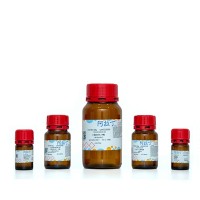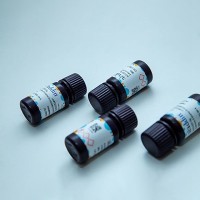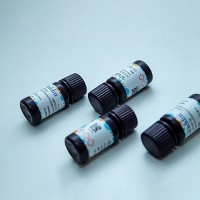简并寡核苷酸基因混编
丁香园
2552
1. 引言
直到近来,创建组合文库的最流行的方法是通过引入点突变产生一系列进化序列的递归策略。对于体外进化来说,比起递归突变的方法,重组聚合酶链反应( PCR;基因混编)有着实践和理论上的优势 [ 1〜3] 。该方法通过重组融合多重点突变的序列和野生型的序列,可快速得到合适的突变蛋白。相关家族基因重组通过将这些基因的片段进行混编,重组后利用 PCR 技术,得到新的基因。该方法的 PCR 组装步骤主要是利用同源重组。因为 “交叉点”经常发生在序列很类似的区域,所以这些方法都需要基因之间有相对高的序列同源性。
如果进行重组的序列之间相似性比较低,则主要产生未重组的 “亲本”基因,需要比较费力地寻找发生重组的基因[ 4 , 5 ] 。Kichuchi 等描述过一种利用 “亲本”基因上的特异限制性酶切位点来进行基因重组的方法 [5]。该方法可以使基因发生混编的频率增高。
我们分离到一种嗜热的 β-木聚糖酶,它在纸浆漂白方面有着优越的表现 [6] 。我们希望通过基因突变的方法获得一种更稳定的以及变化最适 pH 情况下的 β-木聚糖酶。我们首先运用易错聚合酶链反应(error-prone PCR) 和错掺突变,然后进行基因混编,这种方法只能在有限的序列上产生突变,并且需要花费很大精力去筛选
这些突变体。另外,通过 DNA 酶 I 处理的相关家族基因片段,然后进行混编(家族混编),发现主要产物是野生型的序列。为了避免上述情况,通过方法上的改进,我们发明了一种技术,可以使基因重组发生在序列相似性不高和 GC 含量差别很大的片段上,且可以显著减少未发生重组的基因产量。更进一步,可以控制引物延伸的条件,从而使子代基因与亲代基因不同,我们将这种方法称为简并寡核苷酸基因混编(degenerate oligonucleotide gene shuffling,DOGS;参考文献 [ 7 ] ) ,它也可与其他突变技术一起使用。
2. 材料
( 1 ) 基因源:家族 11 木聚糖酶基因来自以下菌株:Dictyoglomus lum strain Rt46 B.1 xynB;Clostridium stercorarium xynB;Bacillus sp. strain V1〜4 ;sp. strain Rt69B.1 xynD;Streptomyces roseiscleroticus xyl3。每个基因都是从相应基因组中扩增出来的。
( 2 ) Pfx 聚合酶(Invitrogen,Victoria,澳大利亚)。
( 3 ) pBSII KS 质粒(Stratagene,San Diego,美国加州)。
( 4 ) 碱性磷酸酶(Roche Diagnostics Australia,NSW,澳大利亚)。
( 5 ) 大肠杆菌 DH5α。
( 6 ) 通用缓冲液:50 mmol/L 磷酸、50 mmol/L 硼酸、50 mmol/L 的乙酸,用氢氧化钠调 pH。
( 7 ) 覆盖液:0.5% 桦木木聚糖(birchwood xylan) (Sigma-Aldrich,Sydney,澳大利亚),0.5% 琼脂糖溶解在 120 mmol/L 的通用缓冲液中,pH 6.5。混合,然后高压灭菌,最后冷却到大约 50°C。
( 8 ) 刚果红溶液(Congo Red) : 1% Congo Red ( Sigma- Aladrich,Sydney,澳大利亚)溶于水。加入氢氧化钠到大约 5 mmol/L,保证溶液的 pH 呈微碱性。
( 9 ) 脱色液:1 mol/L 氯化钠、5 mmol/L 氢氧化钠。
( 10 ) 蛋白质抽提试剂 BPER II (Pierce Chemical Company, Rockford, 美国伊力诺伊州)。
( 11 ) 桦木木聚糖底物溶液:0.5 g 桦木木聚糖溶于 100 ml 的 120 mmol/L 通用缓冲液,pH 6.5。搅拌 5 min 直至溶液均匀,然后高压灭菌。
(12) PAHBAH 储液:分别加入 5 ml 的 0.5 mol/L 的柠檬酸钠、1.0 mol/L 的 Na2SO3、0.2 mol/L CaCl2 和 5.0 mol/L 的 NaOH 到 25 ml 的水中,在加入每种成分前,溶液都要混匀。然后加入 0.76 g p-羟基苯甲酸肼(Sigma- Aldrich),混匀,用水定容到 50 ml。
4. 注
1. DOGS 方法使同源关系较小的基因发生高频率的重组成为可能,而且不需要费时费力的筛选鉴定。CDE 引物可以从整体同源性不高的基因中有效地扩增出用于重组的基因片段。尽管在我们给出的例子中,是用不同物种的木聚糖酶基因进行混编,这一方法也可以被推广到对单一基因的突变库进行混编。可以用最有希望的突变体来替代家族中不同的基因。利用 CDE 引物,将不同的突变体用 PCR 得到,然后按一定的比例混合这些突变体,按照 DOGS 所描述的方法,进行基因改组,可以产生有害的或中性的突变。
2. 某个片段重组的频率可以根据改变该片段加入量的比例来控制,使其发生重组的频率按要求升高或降低( 见 注 4)。相应地,DOGS 方法也可以相对容易的进行结构域的交换,这样就可以替代较早的利用适当的内切酶来进行的交换了。将错掺突变 PCR 整合到 DOGS 方法中,可以产生多样性的重组。在这方面,DOGS 可以仅对基因的某一部分进行突变,从而可以帮助编码基因更好地调控。在这里,可以改变 CDE 引物,使其只对突变的基因片段有简并性。这样,研究者就可以通过在适合的阶段引入保真性缺失的 DNA 聚合酶来控制嵌合基因片段上的特性。
3. 髙保真的 Platinum Pfx 聚合酶被用在所有的 PCR 反应中,以降低错掺突变的发生率。应尽量避免 Tag 酶的使用,因为该酶会使 PCR 产物的 3' 端多个 A,从而使接下来的重叠延伸 PCR 片段间的退火受到干扰。
4. 由于在简并引物的设计中会有错配的设计,所以即使是用高保真 DNA 聚合酶,PCR 也会使核苷酸序列发生改变。如果在扩增和引物延伸步骤中选用保真性不高的酶,则会引入更多的错掺突变。
5. 为了获得需要的嵌合基因,可以用公式 r = ( gx-x ) / ( s-x)来计算亲代基因片段与其他基因片段的混合比例 r。其中 g 是用来混编的基因的个数;x 是每个嵌合基因要求的平均亲代基因的片段数;s 是每个基因的片段数。例如,我们想重组 6 个基因,每个基因分成 8 个片段;平均每个嵌合基因要包括 6 个亲代片段,这样
g = 6,s=8,x=6。用上述公式计算,r 为 15。因此,亲代片段应该以 15 : 1 : 1 : 1 : 1 : 1 的比例与来自其他 5 个基因的片段混合,以期获得平均含有 6 个亲代片段的嵌合基因。
6. 显而易见,利用 DOGS 方法,再结合其他基因混编的方法,则可以产生具备新特性的重组蛋白来。
参考文献
1. Crameri, A. , Whitehorn, E. A. , Tate, E. , and Stemmer, W. P. C. ( 1 99 6 ) Improved green fluorescent protein by molecular evolution using DNA shuffling. Nat. Biotechnol. 14 , 315-319.
2. Stemmer, W. P. C. ( 1 99 4 ) Rapid evolution of a protein in vitro by DNA shuffling. Nature 370, 389-391.
3. Stemmer, W. P. C. ( 1 99 4 ) DNA shuffling by random fragmentation and reassem-bly: in vitro recombination formolecular evolution. Proc. Natl. Acad. USA 9 1 , 1 0747-10751.
4. Schmidt-Dannert, C. , Umeno, D. , and Arnold, F. H. (2000) Molecular breeding of carotenoid biosynthetic pathways. Nature Biotechnol. 1 8 , 750-753.
5. Kikuchi, M. , Ohnishi, K. , and Harayama, S. ( 1 999) Novel family shuffling methods for the in vitro evolution of enzymes. Gene 2 36, 159-167.
6. Morris, D. D. , Gibbs, D. D. , Chin, C. W. , et al. ( 1 998) Cloning of the xynB gene from Dictyoglomus thermophilum strain Rt46B. 1 and action of the gene-product on kraft pulp. Ap p l. Environ. Microbiol. 64, 1759-1765.
7. Gibbs, M. D. , Nevalainen, K. M. H. , and Bergquist, P. L. (200 1 ) Degenerate oligonucleotide gene shuffling(DOGS) : a method for enhancing the frequency of recombination with family shuffling. Gene 27 1 , 13-20.
8. Sakka, K. , Kojima, Y. , Kondo, T. , Karita, S. , Ohmiya, K. , and Shimada, K. ( 1 99 3 ) Nucleotide sequence of the Clostridium stercorarium xynA gene encoding xylanase A : identification of catalytic and cellulose binding domains. Biosci. Biotechnol. Biochem. 5 7, 273-277.
9. Yang, V. W. , Zhuang, Z. , Elegir, G. , and Jeffries, T. W. ( 1 995) Alkaline-active xylanase produced by an alkaliphilic BociZZ m 5 sp. isolated from kraft pulp. J. Ind. Microbiol. 15 , 434-441.
10. Morris, D. D. , Gibbs, M. D. , Ford, M. , Thomas, J. , and Bergquist, P. L. (1 999) FamilylO and 11 xylanase genes from Caldicellulosiruptor isolate Rt69R 1. ExtremophiLes 3, 103-111.
11. Fernandes, A. C. , Fontes, C. M. , Gilbert, H. J. , Hazlewood, G. P. , Fernandes, T. H. , and Ferreira, L. M. ( 1 999) Homologous xylanases from Clostridium thermocellum : evidence for bi-functional activity, synergism between xylanase catalytic modules and the presence of xylan-binding domains ih enzyme complexes. Biochem. J . 34 2, 10 5-110.
12. Elegir, G. , Szakacs, G. , and Jeffries, T. W. ( 1 99 4 ) Purification, characterization and substrate specificity of multiple xylanases from Streptomyces sp. strain Brl2-2. Appl, Environ. Microbiol. 60» 2609-2615.
13. Rose, T. M. , Schultz, E. R. , Henikoff, J. G. , Pietrokovski, S. , McCallum, C. M. , and Henikoff? S ( 1 998) Consensus-degenerate hybrid oligonucleotide primers for amplification of distantly related sequences. Nucleic Acids Res. 26 9 1628-1635.
14. Thompson, J. D. , Gibson, T. J, , Plewniak, R , Jeanmougin, F. , 'and Higgins, D. G. ( 1 997) The ClustalX windows interface: flexible strat^ies for multiple sequence alignment aided by quality analysis tcx)ls. Nucl. Acids Res.24,4876-4882.
15. Rice, P. , Longden, I. , and Bleasby, A. (2000) EMBOSS: The European Molecular Biology Open Software Suite. Trends Genet. 16, 276-277.
16. Ho, S. N. , Hunt, H. D. , Horton, R. M. , Pullen, J. K. , and Pease, L. R. ( 1 989) Site-directed mutagenesis by overlap extension using the polymerase chain reaction. Gene 77, 51-59.
17. Teather, R. M. and Wood, P. J. (1 982) Use of Congo Red polysaccharide interaction in enumeration andcharacterisation of cellulolytic bacteria from bovine rumen. Appl. Environ. Microbiol. 43 , 777-780.
18. Lever, M. (1 97 3 ) Colorimetric and fluorometric carbohydrate determination with /^-hydroxybenzoic acid hydrazide. Biochem. Med.7, 274-28 1.
19. Britton, H. T. S. and Robinson, R. A. (1 9 31 ) Universal buffer solutions and the dissociation constant of veronal. J . Chem. Soc. 1 , 1456 -146 2.
直到近来,创建组合文库的最流行的方法是通过引入点突变产生一系列进化序列的递归策略。对于体外进化来说,比起递归突变的方法,重组聚合酶链反应( PCR;基因混编)有着实践和理论上的优势 [ 1〜3] 。该方法通过重组融合多重点突变的序列和野生型的序列,可快速得到合适的突变蛋白。相关家族基因重组通过将这些基因的片段进行混编,重组后利用 PCR 技术,得到新的基因。该方法的 PCR 组装步骤主要是利用同源重组。因为 “交叉点”经常发生在序列很类似的区域,所以这些方法都需要基因之间有相对高的序列同源性。
如果进行重组的序列之间相似性比较低,则主要产生未重组的 “亲本”基因,需要比较费力地寻找发生重组的基因[ 4 , 5 ] 。Kichuchi 等描述过一种利用 “亲本”基因上的特异限制性酶切位点来进行基因重组的方法 [5]。该方法可以使基因发生混编的频率增高。
我们分离到一种嗜热的 β-木聚糖酶,它在纸浆漂白方面有着优越的表现 [6] 。我们希望通过基因突变的方法获得一种更稳定的以及变化最适 pH 情况下的 β-木聚糖酶。我们首先运用易错聚合酶链反应(error-prone PCR) 和错掺突变,然后进行基因混编,这种方法只能在有限的序列上产生突变,并且需要花费很大精力去筛选
这些突变体。另外,通过 DNA 酶 I 处理的相关家族基因片段,然后进行混编(家族混编),发现主要产物是野生型的序列。为了避免上述情况,通过方法上的改进,我们发明了一种技术,可以使基因重组发生在序列相似性不高和 GC 含量差别很大的片段上,且可以显著减少未发生重组的基因产量。更进一步,可以控制引物延伸的条件,从而使子代基因与亲代基因不同,我们将这种方法称为简并寡核苷酸基因混编(degenerate oligonucleotide gene shuffling,DOGS;参考文献 [ 7 ] ) ,它也可与其他突变技术一起使用。
2. 材料
( 1 ) 基因源:家族 11 木聚糖酶基因来自以下菌株:Dictyoglomus lum strain Rt46 B.1 xynB;Clostridium stercorarium xynB;Bacillus sp. strain V1〜4 ;sp. strain Rt69B.1 xynD;Streptomyces roseiscleroticus xyl3。每个基因都是从相应基因组中扩增出来的。
( 2 ) Pfx 聚合酶(Invitrogen,Victoria,澳大利亚)。
( 3 ) pBSII KS 质粒(Stratagene,San Diego,美国加州)。
( 4 ) 碱性磷酸酶(Roche Diagnostics Australia,NSW,澳大利亚)。
( 5 ) 大肠杆菌 DH5α。
( 6 ) 通用缓冲液:50 mmol/L 磷酸、50 mmol/L 硼酸、50 mmol/L 的乙酸,用氢氧化钠调 pH。
( 7 ) 覆盖液:0.5% 桦木木聚糖(birchwood xylan) (Sigma-Aldrich,Sydney,澳大利亚),0.5% 琼脂糖溶解在 120 mmol/L 的通用缓冲液中,pH 6.5。混合,然后高压灭菌,最后冷却到大约 50°C。
( 8 ) 刚果红溶液(Congo Red) : 1% Congo Red ( Sigma- Aladrich,Sydney,澳大利亚)溶于水。加入氢氧化钠到大约 5 mmol/L,保证溶液的 pH 呈微碱性。
( 9 ) 脱色液:1 mol/L 氯化钠、5 mmol/L 氢氧化钠。
( 10 ) 蛋白质抽提试剂 BPER II (Pierce Chemical Company, Rockford, 美国伊力诺伊州)。
( 11 ) 桦木木聚糖底物溶液:0.5 g 桦木木聚糖溶于 100 ml 的 120 mmol/L 通用缓冲液,pH 6.5。搅拌 5 min 直至溶液均匀,然后高压灭菌。
(12) PAHBAH 储液:分别加入 5 ml 的 0.5 mol/L 的柠檬酸钠、1.0 mol/L 的 Na2SO3、0.2 mol/L CaCl2 和 5.0 mol/L 的 NaOH 到 25 ml 的水中,在加入每种成分前,溶液都要混匀。然后加入 0.76 g p-羟基苯甲酸肼(Sigma- Aldrich),混匀,用水定容到 50 ml。
4. 注
1. DOGS 方法使同源关系较小的基因发生高频率的重组成为可能,而且不需要费时费力的筛选鉴定。CDE 引物可以从整体同源性不高的基因中有效地扩增出用于重组的基因片段。尽管在我们给出的例子中,是用不同物种的木聚糖酶基因进行混编,这一方法也可以被推广到对单一基因的突变库进行混编。可以用最有希望的突变体来替代家族中不同的基因。利用 CDE 引物,将不同的突变体用 PCR 得到,然后按一定的比例混合这些突变体,按照 DOGS 所描述的方法,进行基因改组,可以产生有害的或中性的突变。
2. 某个片段重组的频率可以根据改变该片段加入量的比例来控制,使其发生重组的频率按要求升高或降低( 见 注 4)。相应地,DOGS 方法也可以相对容易的进行结构域的交换,这样就可以替代较早的利用适当的内切酶来进行的交换了。将错掺突变 PCR 整合到 DOGS 方法中,可以产生多样性的重组。在这方面,DOGS 可以仅对基因的某一部分进行突变,从而可以帮助编码基因更好地调控。在这里,可以改变 CDE 引物,使其只对突变的基因片段有简并性。这样,研究者就可以通过在适合的阶段引入保真性缺失的 DNA 聚合酶来控制嵌合基因片段上的特性。
3. 髙保真的 Platinum Pfx 聚合酶被用在所有的 PCR 反应中,以降低错掺突变的发生率。应尽量避免 Tag 酶的使用,因为该酶会使 PCR 产物的 3' 端多个 A,从而使接下来的重叠延伸 PCR 片段间的退火受到干扰。
4. 由于在简并引物的设计中会有错配的设计,所以即使是用高保真 DNA 聚合酶,PCR 也会使核苷酸序列发生改变。如果在扩增和引物延伸步骤中选用保真性不高的酶,则会引入更多的错掺突变。
5. 为了获得需要的嵌合基因,可以用公式 r = ( gx-x ) / ( s-x)来计算亲代基因片段与其他基因片段的混合比例 r。其中 g 是用来混编的基因的个数;x 是每个嵌合基因要求的平均亲代基因的片段数;s 是每个基因的片段数。例如,我们想重组 6 个基因,每个基因分成 8 个片段;平均每个嵌合基因要包括 6 个亲代片段,这样
g = 6,s=8,x=6。用上述公式计算,r 为 15。因此,亲代片段应该以 15 : 1 : 1 : 1 : 1 : 1 的比例与来自其他 5 个基因的片段混合,以期获得平均含有 6 个亲代片段的嵌合基因。
6. 显而易见,利用 DOGS 方法,再结合其他基因混编的方法,则可以产生具备新特性的重组蛋白来。
参考文献
1. Crameri, A. , Whitehorn, E. A. , Tate, E. , and Stemmer, W. P. C. ( 1 99 6 ) Improved green fluorescent protein by molecular evolution using DNA shuffling. Nat. Biotechnol. 14 , 315-319.
2. Stemmer, W. P. C. ( 1 99 4 ) Rapid evolution of a protein in vitro by DNA shuffling. Nature 370, 389-391.
3. Stemmer, W. P. C. ( 1 99 4 ) DNA shuffling by random fragmentation and reassem-bly: in vitro recombination formolecular evolution. Proc. Natl. Acad. USA 9 1 , 1 0747-10751.
4. Schmidt-Dannert, C. , Umeno, D. , and Arnold, F. H. (2000) Molecular breeding of carotenoid biosynthetic pathways. Nature Biotechnol. 1 8 , 750-753.
5. Kikuchi, M. , Ohnishi, K. , and Harayama, S. ( 1 999) Novel family shuffling methods for the in vitro evolution of enzymes. Gene 2 36, 159-167.
6. Morris, D. D. , Gibbs, D. D. , Chin, C. W. , et al. ( 1 998) Cloning of the xynB gene from Dictyoglomus thermophilum strain Rt46B. 1 and action of the gene-product on kraft pulp. Ap p l. Environ. Microbiol. 64, 1759-1765.
7. Gibbs, M. D. , Nevalainen, K. M. H. , and Bergquist, P. L. (200 1 ) Degenerate oligonucleotide gene shuffling(DOGS) : a method for enhancing the frequency of recombination with family shuffling. Gene 27 1 , 13-20.
8. Sakka, K. , Kojima, Y. , Kondo, T. , Karita, S. , Ohmiya, K. , and Shimada, K. ( 1 99 3 ) Nucleotide sequence of the Clostridium stercorarium xynA gene encoding xylanase A : identification of catalytic and cellulose binding domains. Biosci. Biotechnol. Biochem. 5 7, 273-277.
9. Yang, V. W. , Zhuang, Z. , Elegir, G. , and Jeffries, T. W. ( 1 995) Alkaline-active xylanase produced by an alkaliphilic BociZZ m 5 sp. isolated from kraft pulp. J. Ind. Microbiol. 15 , 434-441.
10. Morris, D. D. , Gibbs, M. D. , Ford, M. , Thomas, J. , and Bergquist, P. L. (1 999) FamilylO and 11 xylanase genes from Caldicellulosiruptor isolate Rt69R 1. ExtremophiLes 3, 103-111.
11. Fernandes, A. C. , Fontes, C. M. , Gilbert, H. J. , Hazlewood, G. P. , Fernandes, T. H. , and Ferreira, L. M. ( 1 999) Homologous xylanases from Clostridium thermocellum : evidence for bi-functional activity, synergism between xylanase catalytic modules and the presence of xylan-binding domains ih enzyme complexes. Biochem. J . 34 2, 10 5-110.
12. Elegir, G. , Szakacs, G. , and Jeffries, T. W. ( 1 99 4 ) Purification, characterization and substrate specificity of multiple xylanases from Streptomyces sp. strain Brl2-2. Appl, Environ. Microbiol. 60» 2609-2615.
13. Rose, T. M. , Schultz, E. R. , Henikoff, J. G. , Pietrokovski, S. , McCallum, C. M. , and Henikoff? S ( 1 998) Consensus-degenerate hybrid oligonucleotide primers for amplification of distantly related sequences. Nucleic Acids Res. 26 9 1628-1635.
14. Thompson, J. D. , Gibson, T. J, , Plewniak, R , Jeanmougin, F. , 'and Higgins, D. G. ( 1 997) The ClustalX windows interface: flexible strat^ies for multiple sequence alignment aided by quality analysis tcx)ls. Nucl. Acids Res.24,4876-4882.
15. Rice, P. , Longden, I. , and Bleasby, A. (2000) EMBOSS: The European Molecular Biology Open Software Suite. Trends Genet. 16, 276-277.
16. Ho, S. N. , Hunt, H. D. , Horton, R. M. , Pullen, J. K. , and Pease, L. R. ( 1 989) Site-directed mutagenesis by overlap extension using the polymerase chain reaction. Gene 77, 51-59.
17. Teather, R. M. and Wood, P. J. (1 982) Use of Congo Red polysaccharide interaction in enumeration andcharacterisation of cellulolytic bacteria from bovine rumen. Appl. Environ. Microbiol. 43 , 777-780.
18. Lever, M. (1 97 3 ) Colorimetric and fluorometric carbohydrate determination with /^-hydroxybenzoic acid hydrazide. Biochem. Med.7, 274-28 1.
19. Britton, H. T. S. and Robinson, R. A. (1 9 31 ) Universal buffer solutions and the dissociation constant of veronal. J . Chem. Soc. 1 , 1456 -146 2.






